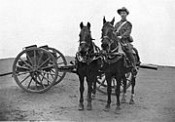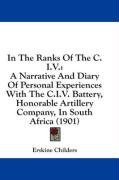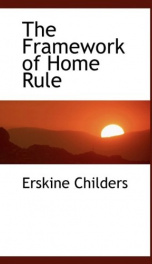Childers Erskine

Robert Erskine Childers DSC (25 June 1870 – 24 November 1922), universally known as Erskine Childers,[1][2][3] (pronounced /ˈɜrskɨn ˈtʃɪldərz/)[4] was the author of the influential novel Riddle of the Sands and an Irish nationalist, who was executed by the authorities of the nascent Irish Free State during the Irish Civil War. He was the son of British Orientalist scholar Robert Caesar Childers; the cousin of Hugh Childers and Robert Barton; and the father of the fourth President of Ireland, Erskine Hamilton Childers. Childers was born in Mayfair, London, the second son to Robert Caesar Childers, a translator and oriental scholar from an ecclesiastical family, and Anna Mary Henrietta, née Barton, from an Anglo-Irish landowning family of Glendalough House, Annamoe, County Wicklow[5] with interests in France such as the winery that bears their name. When Erskine was six his father died from tuberculosis and, although seemingly healthy, Anna was confined to an isolation hospital, where she was to die six years later. The children, by this time numbering five, were sent to the Bartons at Glendalough. They were treated kindly there and Erskine came to identify himself closely with the country of Ireland, albeit at that stage from the comfortable viewpoint of the "Protestant Ascendancy".[6] At the recommendation of his grandfather, Canon Charles Childers, he was sent to Haileybury College. There he won an exhibition to Trinity College, Cambridge, studying the classical tripos and then law.[7] He distinguished himself as the editor of Cambridge Review, a university magazine. Notwithstanding his unattractive voice and poor debating skills, he became president of the Trinity College Debating Society (the "Magpie and Stump" society). Although Erskine was an admirer of his cousin Hugh Childers, a member of the Cabinet in favour of Irish home rule, he spoke vehemently against the policy in college debates.[5] A sciatic injury sustained while hill walking in the summer before he went up, and which was to dog him for the rest of his life, had left him slightly lame and he was unable to pursue his intention of earning a rugby blue, but he became a proficient rower.[8] Having gained his degree in law, and with the vague intention of one day following cousin Hugh into parliament as an MP,[9] Childers sat the competitive entry examination to become a parliamentary clerk. He was successful and early in 1895 he became a junior committee clerk, with the responsibility of preparing formal and legally sound bills from the proposals of the government of the day. With many sporting ventures now closed to him because of his persisting sciatic injury, Childers was encouraged by Walter Runciman, a friend from schooldays, to take up sailing. After picking up the fundamentals of seamanship as a deckhand on Runciman's yacht, in 1893 he bought his own vessel, the "scrubby little yacht" Sheila, which he learned to sail alone on the Thames estuary.[10][11] Bigger and better boats followed: by 1895 he was taking the half-deck Marguerite across the Channel and in 1897 there was a long cruise to the Frisian Islands, Norderney and the Baltic with his brother Henry in the thirty-foot cutter Vixen: a voyage he repeated in the following spring. These were the adventures he was to fictionalise in 1903 as The Riddle of the Sands, his most famous book.[12] In 1903 Childers, now accompanied by his new wife Molly, was again cruising in the Frisian Islands, in Sunbeam, a boat he shared with William le Fanu and other friends from his university days. However his father-in-law, Dr Hamilton Osgood, had arranged for a fine 28-ton yacht, Asgard, to be built for the couple as a wedding gift and Sunbeam was only a temporary measure while Asgard was being fitted out.[13] This was Childers's last, and most famous, yacht: in June 1914 he used it to smuggle a cargo of 900 Mauser rifles and 29,000 rounds of ammunition to the Irish Volunteers movement at the fishing village of Howth, Co Dublin.[5] It was acquired by the Irish government as a sail training vessel in 1961, stored on dry land in the yard of Kilmainham Gaol in 1979, and finally becoming a static exhibit at The National Museum of Ireland in 1997.[14][15] As with most men of his social background and education, Childers was a steadfast believer in the British Empire. Indeed for an old boy of Haileybury, a school founded to train young men for colonial service in India, this outlook was almost inevitable,[16] although he had given the matter some critical consideration.[17] In 1898, then, as negotiations over the voting rights of British settlers in the Boer territories of Transvaal and Orange Free State failed and the Boer War broke out, he needed little encouragement when in December Basil Williams, a colleague at Westminster and already a member of the volunteer Honourable Artillery Company, suggested that they should enlist together.[18] It was, therefore, as an artilleryman that Childers joined the City Imperial Volunteers, something of an ad-hoc force comprising soldiers from different territorial regiments, but funded by City institutions and provided with the most modern equipment. He was classed as a "driver", caring for a pair of horses and riding them in the gun train. The unit set off for South Africa on 2 February 1899 and here Childers's sailing experience was useful: most of the new volunteers, and their officers, were seasick and it largely fell to him to care for the troop's six horses.[18] After the three-week voyage it was something of a disappointment that the HAC detachment was, initially, not used. It was not until 26 June, while escorting a supply train of slow ox-wagons, that Childers first experienced enemy fire, in three days of skirmishing in defence of the column. However it was a smartly-executed defence of a beleaguered infantry regiment on 3 July that established their worth and more significant engagements followed.[19] On 24 August Childers was evacuated from the front line, not as the result of a wound but from a type of trench foot, to hospital in Pretoria. The seven-day journey happened to be in the company of wounded infantrymen from Cork, Ireland, and Childers noted approvingly how cheerfully loyal to Britain the men were, how resistant to any incitement in support of Irish home rule and how they had been let down only by the incompetence of their officers.[20] This is a striking contrast to the attitude he was to note towards the end of the First World War when conscription in Ireland was under consideration: "...young men hopelessly estranged from Britain and...anxious to die in Ireland for Irish liberty."[21] After a chance meeting with his brother Henry, also suffering from a foot injury, he rejoined his unit, only for it to be despatched to England on 7 October 1899. Childers's attitude to Britain's establishment and politics was somewhat equivocal at the start of the First World War. He had resigned his membership of the Liberal Party, and with it his hopes of winning a parliamentary seat, over concessions to Unionists and a further postponement of Irish self-rule;[5] he had written works critical of British policy in Ireland and in its South African possessions; above all, in July 1914, he had smuggled a shipment of arms bought in Germany to supply rebels in Ireland.[5] This knowledge was not in wide circulation, but neither was it a great secret,[22] and the official telegram calling Childers to naval service was sent to the Dublin headquarters of the Irish Volunteers, the group to which he had made the delivery.[23] Although in 1914 it could be argued that, in the case of war, the Irish Volunteers might fight on the side of Britain as a means of securing bargaining power in home rule negotiations, these weapons were used against British soldiers, diverted from fighting the enemy, in The Easter Rising of 1916.[24][25] Then again, Childers believed that smaller nations such as Belgium and Serbia would benefit from Britain's defeat of Germany and, as a prospectively independent nation, Ireland too would gain.[5] If Childers's support for England in the fight against Germany may have been in some doubt, when in mid-August 1914 he did once again volunteer, the grant of a reserve commission in the intelligence arm of the Royal Navy was entirely to be expected: Winston Churchill, the First Lord of the Admiralty, although hostile to spending money on armaments at the time The Riddle of the Sands was published,[26] later gave the book the credit for persuading public opinion to fund vital measures against the German naval threat, and he was instrumental in securing Childers's recall.[26][27] His first task was a neat reversal of his plot for The Riddle of the Sands: to draw up a plan for the invasion of Germany by way of the Frisian Islands.[28] Only a few days later he found himself allocated to HMS Engadine, a seaplane support vessel, as an instructor in coastal navigation to newly trained pilots. He managed to extend his duties to include flying as a navigator and observer, including a sortie navigating over a familiar coastline in the Cuxhaven Raid, an inconclusive bombing attack on the Cuxhaven airship base on Christmas Day 1914.[29] In 1915 he was transferred in a similar role to HMS Ben-my-Chree, in which he served in the Gallipoli Campaign and the eastern Mediterranean, earning himself a Distinguished Service Cross.[30] He was sent back to London in April 1916 to receive his decoration from the king and for service in the Admiralty. This period in his life is relatively undocumented and his Irish detractors were to allege that he was once again engaged in intelligence work. In reality he was engaged in the mundane task of allocating seaplanes to their intended ships.[25] It took Childers until autumn of that year to extricate himself and train for service with a new coastal motor-boat squadron operating in the English Channel.[31] A respite from Childers's military career was offered on 27 July 1917, when Sir Horace Plunkett asked that he be assigned to the secretariat of Prime Minister Lloyd George's Home Rule Convention initiative in Dublin Castle.[32] The enterprise failed and, on his return to London in April 1918, Childers found that, as a naval flyer, he had been transferred into the newly created Royal Air Force. No job was found for him until Hugh Trenchard formed his Independent Bomber Command and he was attached as a group intelligence officer to prepare navigational briefings for attacks on Berlin. The raids were forestalled by the Armistice and Childers's last assignment was to provide an intelligence assessment of the effects of bombing raids in Belgium.[33]
do you like this author?
What readers are saying
What do you think? Write your own comment on this book!
write a commentWhat readers are saying
What do you think? Write your own comment on this author!
write a commentBook list

In the Ranks of the C.I.V.
Series:
Unknown
Year:
Unknown
Raiting:
4/5
Many of the earliest books, particularly those dating back to the 1900s and before, are now extremely scarce and increasingly expensive. We are republishing these classic works in affordable, high quality, modern editions, using the original text and artwork.
Show more
add to favoritesadd In favorites

The Framework of Home Rule
Series:
Unknown
Year:
Unknown
Raiting:
3.5/5
My purpose in this volume is to advocate a definite scheme of self-government for Ireland. That task necessarily involves an historical as well as a constructive argument. It would be truer perhaps to say that the greater part of the constructive case for Home Rule must necessarily be historical. (Excerpt from Introduction) --This text refers to an alternate Paperback edition.
Show more
add to favoritesadd In favorites
Book list

In the Ranks of the C.I.V.
Series:
Unknown
Year:
Unknown
Raiting:
4/5
Many of the earliest books, particularly those dating back to the 1900s and before, are now extremely scarce and increasingly expensive. We are republishing these classic works in affordable, high quality, modern editions, using the original text and artwork.
Show more
add to favoritesadd In favorites

The Framework of Home Rule
Series:
Unknown
Year:
Unknown
Raiting:
3.5/5
My purpose in this volume is to advocate a definite scheme of self-government for Ireland. That task necessarily involves an historical as well as a constructive argument. It would be truer perhaps to say that the greater part of the constructive case for Home Rule must necessarily be historical. (Excerpt from Introduction) --This text refers to an alternate Paperback edition.
Show more
add to favoritesadd In favorites
What readers are saying
What do you think? Write your own comment on this author!
write a commentif you like Childers Erskine try:
readers also enjoyed
What readers are saying
What do you think? Write your own comment on this author!
write a commentGenre
if you like Childers Erskine try:
readers also enjoyed
Do you want to exchange books? It’s EASY!
Get registered and find other users who want to give their favourite books to good hands!


